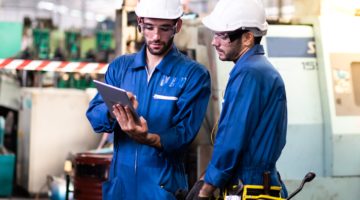Many working in industries with remote assets such as Energy, Mining and Engineering Services have been aware for some time of the benefits of technologies such as AI (Artificial Intelligence) and IoT (Internet of Things). These advantages have been brought into clear focus over the last few weeks as we all adjust to the challenges of the global pandemic.
Though we are all keen to return to normal working conditions, one by-product of this challenging period is that we can learn to work smarter and think twice about unnecessary travel – a win-win for both productivity and the environment. But how can we effectively inspect and maintain remote assets during times of social distancing, working from home and isolation?
The Risks and Challenges of Maintaining Remote Assets
It’s crucial to productivity and effective cost management that remote assets such as pumps, compressors, flares on oil rigs or ball mills in mining excavation are well maintained. That often means teams of specialist operatives are travelling out to remote locations to inspect and maintain equipment – although this approach isn’t without its risks and challenges:
- Risk of infection transmission – Often operatives will be working closely in specialist teams. Even before COVID-19 started to take Progressive TSL’s African clients already aware of the threat of infectious diseases and the risks of transmission on–site.
- Other Physical Risks – from offshore rigs prone to fires to increased toxicity level in underground mines, operatives in our asset-intensive industries are exposed to many hazards.
- Security Risks – Travelling alone or in small groups can put operatives at risk of attack – particularly if travelling through war zones, or areas with a high risk of terrorism and general instability.
- Depleted workforce – Over the coming months we may find operative numbers reduce as the need to self isolate intensifies, companies may start to find they don’t have the staff available to perform necessary maintenance and inspections as they are being pulled onto other tasks.
- Costs of travel to remote assets – Even without taking into account the HSE impact of these jobs, there are significant costs associated with sending operatives out to inspect and maintain remote kit.
Now is the time to make the jump from early to mass adoption
We may have seen an abundance of presentations about IoT and digitalisation at conferences and read white papers over recent years. However, in reality, asset-intensive industries are only just starting to move from innovation to the early adoption phase, with onboarding being typically left to the large caps such as Exxon Mobil, Shell, Rio Tinto.
There’s never been such a compelling case for mass adoption of these technologies:
“The immediate impact of an IoT monitoring network on operational efficiency, safety and sustainability will soon outweigh the initial costs and advance companies’ competitive edge in the oil & gas marketplace.”
How IoT is transforming Oil and Gas Pipeline Management: IoT for All
Digitalisation Can Address the Challenges
- Remote inspections
We can now collect huge amounts of data about the health of the assets without having to visit the assets physically. Though our clients will always make HSE the highest priority, monitoring variables such as ventilation and toxicity levels from afar and triggering evacuations remotely is still the best approach. The latest generation of assets comes with inbuilt IoT sensors, and most assets can already be linked up to SCADA systems. As an example, the fleet of trucks carrying extracted raw materials from a Progressive client’s gold mines are some of the most critical assets. They are all fully equipped with IoT sensors that collect vast amounts of data about the health of the trucks to be sent to a Fleet Management system. Woodside Energy, Australia’s largest upstream oil and gas producer, are taking the next innovative step, running robotics trials in collaboration with NASA; see their video on this project.
“We really see that robotics could be used in many activities as an assistant to our operators and maintainers so that they can be removed from some of the more hazardous tasks and allow us to maintain and operate our facilities in a different manner” – Ali Barnes, Head of Robotics at Woodside Energy. - Reduce Reliance on specialists
Holo One explains that their augmented reality technology adds new value via remote assistance. In other words, highly paid engineers can control several assets in real-time, from wherever they are in the world. This is made possible with an AR headset, for example, HoloLens. - Protect remote workers from security threats
HxGN EAM (formerly Infor EAM) provides a range of functions to address challenges. For instance, their POB (People on Board) technology provides a centralised view of workers location, start and finish, accommodation etc. Wearable technology enables us to track remote operators out in the field, Progressive TSL’s EAM Senior Consultant Jon Barker discusses the future of wearables in his recent interview“When it comes to health and safety benefits for lone workers, wearables will be a great benefit. When people are working on their own, often in remote places, their colleagues can check their wellbeing by monitoring their locations, heartbeat, temperature etc. This can identify whether they have been injured are sick or in other danger, and help can get to them quicker.”
Jon Barker, Progressive TSL
- Predictive Maintenance Strategies
As we discussed in our previous blog – it’s crucial to adopt a sound maintenance strategy that manages the delicate balance between minimising unnecessary maintenance and inspection costs without a reduction in productivity as a direct result of poorly maintained kit. IoT can not only offer you real-time warnings but through its consistent collection of data, you can start to identify trends and patterns. These can better predict when maintenance is necessary and avoid performing unnecessary costly and labour-intensive inspections.Infor’s long term client CERN home to the famous particle accelerators uses Infor’s Coleman AI platform alongside Infor Data Lake Infor EAM to address the challenges of unnecessary maintenance and downtime for explains:
This is a result of an inability to filter out the “noise” of inconsequential device readings (airflow). The accelerator’s complex uptimes can be severely impacted by individual asset failures. By predicting airflow trends for individual devices, CERN are able to move from time-based preventative maintenance to predictive maintenance reducing the number of false alarms and corrective interventions.”
How Progressive TSL can help
Progressive TSL are Infor Gold Channel Partners and specialists in the implementation of asset management Infor EAM (Enterprise Asset Management) asset-intensive industries, including mining, energy and engineering services. Based on our long-term experience working with these industries, we can provide advice on how digitalisation can address your specific needs in the management of remote assets and the appropriate technology to address this. We can also offer solutions to overcome connectivity challenges at remote, offshore or underground sites through the use of Progressive TSL’s ProSync.
To discuss the specific challenges of maintaining your remote assets please contact Progressive TSL to arrange a no-obligation exploratory video call.




